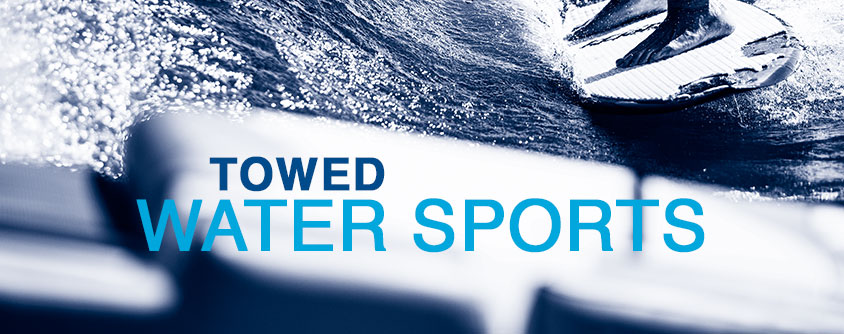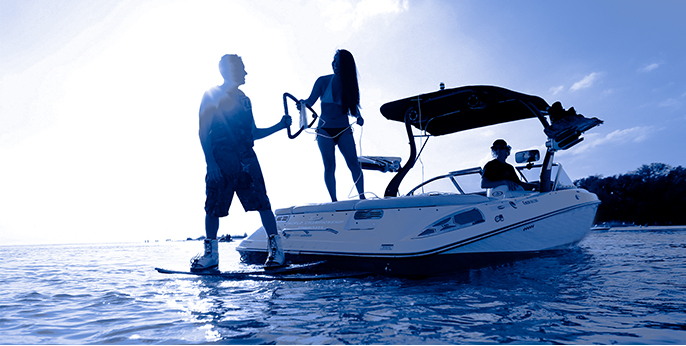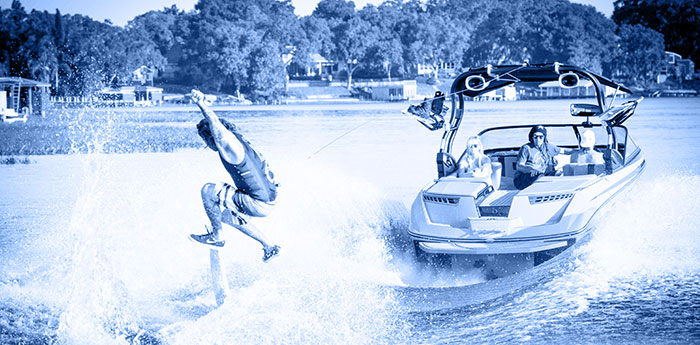
For fun that lasts, think safety first
Safety Guidelines
Boating Safety Awareness Series—A Public Service of the National Marine Manufacturers Association
BEFORE HITTING THE WATER
- Every rider, skier and boater should wear a suitably sized, U.S. Coast Guard-approved life jacket (this is the law in many states). Special life jackets are also available for specific types of water sports.
- Read and heed all warning labels and instructions on the boat and in the owner’s manual. Be aware of the potential of carbon monoxide (CO) poisoning and propeller strike hazards.
- Read, understand and follow the operator guidelines for the boat, water sports and safety equipment.
- Always boat sober. Alcohol and drugs don’t mix with boating. Boating under the influence (BUI) is illegal in every state.
- Both driver and observer should be experienced and both should know the rider/skier’s abilities, desired tow speed, and how long they want to stay on the water.
- Be sure the observer knows their responsibilities including watching for boats approaching from astern and communicating information to the driver.
- Know the hand signals for communication before starting. The driver must insist that riders/skiers give the “OK” signal after a fall. Always use the “stop”, “faster” and “slower” signals as needed. Contact USA Water Ski for universal hand signal information.
- The driver should be aware of no wake zones and the impact of their boat’s wake on private property, docks, swimmers and other boats.
- Know your state’s boating laws and local lake rules before you head out. Know the area where you are boating.
- Learn the nautical “rules of the road” by taking a boating safety education course. The United States Power Squadrons® and the U.S. Coast Guard Auxiliary offer courses throughout the U.S. Also, BoatUS offers online state specific boating safety courses.

WHILE ON THE WATER
- Shut off the engine when anyone is nearby in the water to reduce the possibility of carbon monoxide poisoning or propeller strikes. Never depend on neutral; the propeller may spin in neutral or the transmission may inadvertently shift into gear and endanger a person in the water.
- Always use both an experienced driver and observer in the boat. Keep passengers in view when they enter or exit the boat. Always approach the person in the water on the driver’s side (and from downwind, where possible), and shut off the engine before allowing anyone to approach the boat. Never “back up” towards anyone in the water.
- Always keep the rider/skier in sight. Whenever someone is in the water and not being towed, alert other boaters to take caution such as by displaying a “skier down” flag.
- Visually check for people in the water behind the boat and attach the engine cut-off lanyard before starting the engine.
- Stay at least 150 feet from all other objects and people (e.g., boats, piers, docks, buoys, other floating items, swimmers). Be sure to follow all local rules.
- Never participate in water sports close to shore or near swimming areas, in shallow water or in water where you do not know the depth or what is beneath the surface.
- Choose a water sports area away from anglers, swimmers, divers, moorings, channel markers, other watercraft, shallow areas or reefs and any other dangers to participants. Always avoid shipping channels.
- Watch tow lines so they do not get tangled in the propeller. Keep passengers away from tow lines. Do not allow riders or passengers to wrap their limbs or body in the tow rope. Use only tow lines appropriate for the sport.
- Slowly remove slack from the towline before accelerating. Follow the approved tow pattern and tow hours in each water sports area. Maintain a safe speed and do not make sudden, unexpected turns.
- Ensure that each passenger is properly seated in a designated occupant position to avoid falling or falling overboard. Passengers should not sit in locations that obstruct the driver’s visibility. If the boat has a bow seating area, do not exceed the manufacturer’s bow seating capacity. Assure passengers use hand holds.

EQUIPMENT SAFETY CHECKS
- Perform the pre- and post-operation checks and inspections outlined in the equipment manuals, including proper operation of the engine cut-off lanyard and condition of the lanyard.
- Inspect all towed equipment for wear, fraying, cuts, damage and unnecessary knots before and after each use. Repair or replace equipment when it starts to show wear—well before it breaks.
- Inspect life jackets for rips and tears, and buckles for breakage.
- Be sure all other equipment on the boat is properly stowed.
- Ensure proper tow points are used for the type of activity you are engaged in.
- After use, towlines should be disconnected from the boat and properly stowed. Bindings, towables and all other equipment should be kept out of the sun when not in use; prolonged exposure to sunlight may damage equipment and towlines.
- Have all boat systems checked for proper operation by a certified marine technician at least once a year
3
IT TAKES THREE TO PARTICIPATE IN TOWED WATER SPORTS!
THE FACTS
Nothing beats boating and water sports as a way to relax, have fun, and bring family and friends together. That is why it’s so tragic that more than 700 boaters die and thousands are injured each year in the United States.
Most boating accidents involved alcohol, operator inattention, careless and reckless operation, inexperience, improper boat maintenance, failure to follow the nautical “rules of the road” or failure to wear life jackets. Water sports present additional hazards to both boat operators and water sports participants.
- The U.S. Coast Guard estimates that wearing a life jacket would save the lives of more than 450 people a year.
- Most injuries result from collisions with other objects. Operators must know where they and their participants are going and what’s happening around them. Participants must stay away from other objects and be mindful of boating traffic in the area.
- Water sports participants can be seriously injured by a propeller as they enter or exit the boat.
- Prolonged exposure to engine exhaust can cause serious injury or death due to carbon monoxide (CO).
- Nine out of ten fatalities occur on boats where the operator has not completed a boating safety education course.
ALMOST ALL INJURIES AND FATALITIES CAN BE PREVENTED.
To find out more information contact:
National Marine Manufacturers Association
231 S. LaSalle Street, Suite 2050
Chicago, IL 60604
nmma.org
discoverboating.com
312.946.6200
231 S. LaSalle Street, Suite 2050
Chicago, IL 60604
nmma.org
discoverboating.com
312.946.6200
United States Coast Guard
Office of Auxiliary and Boating Safety
Commandant (CG-BSX-2) Stop – 7501
2703 Martin Luther King Jr. Ave., S.E.
Washington, DC 20593-7501
uscgboating.org
202.372.1062
Office of Auxiliary and Boating Safety
Commandant (CG-BSX-2) Stop – 7501
2703 Martin Luther King Jr. Ave., S.E.
Washington, DC 20593-7501
uscgboating.org
202.372.1062
BoatUS Foundation
147 Old Solomons Island Road, Suite 513
Annapolis, MD 21401
boatus.org
800.245.2628
147 Old Solomons Island Road, Suite 513
Annapolis, MD 21401
boatus.org
800.245.2628
This brochure is published by NMMA for educational purposes only and it should not be assumed that all relevant safety information is included herein. NMMA makes no guarantee, representation or warranty, express or implied, at law or in equity, as to the validity, accuracy or sufficiency of the information included in this brochure. NMMA assumes no responsibility or liability for any injuries, claims, losses or damages arising in connection with the use of or reliance on the information included in this brochure.
POWERED BY 
